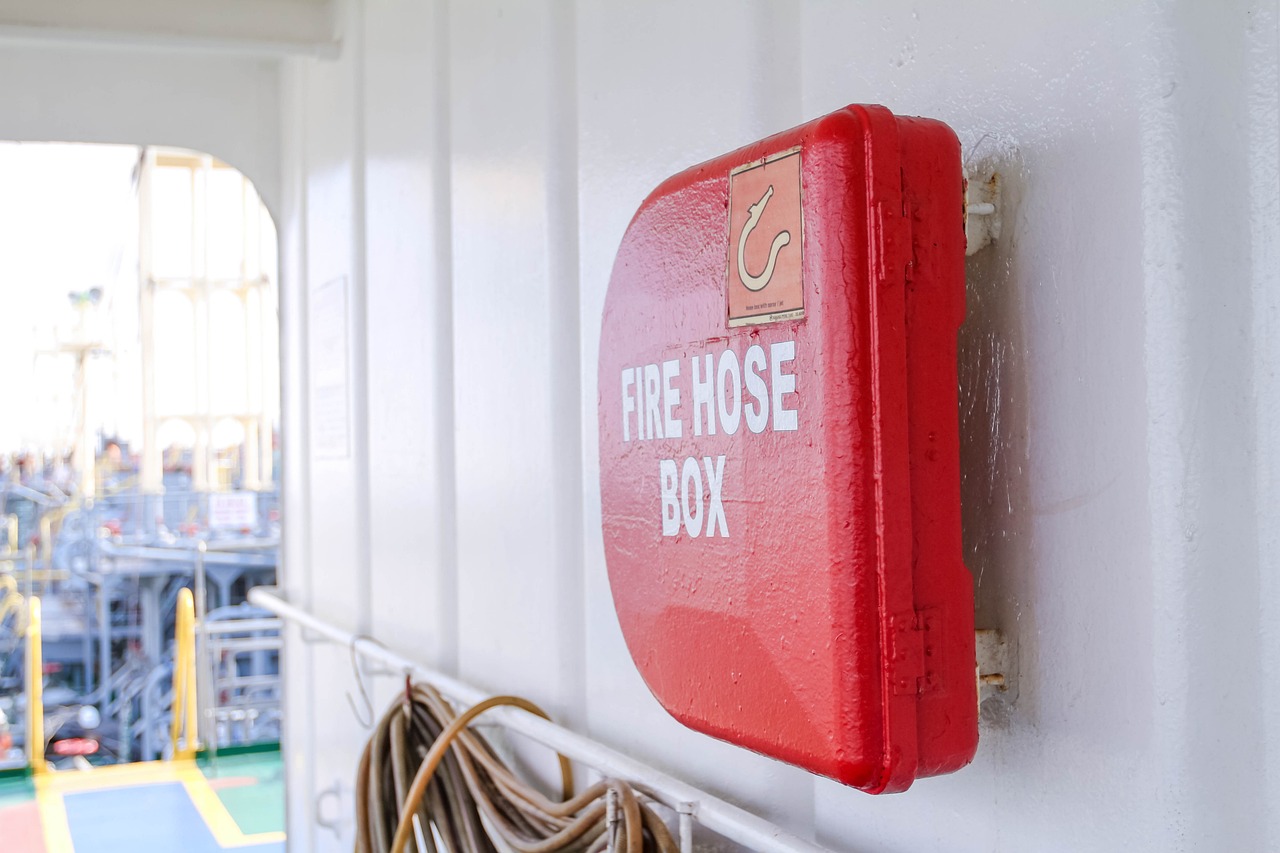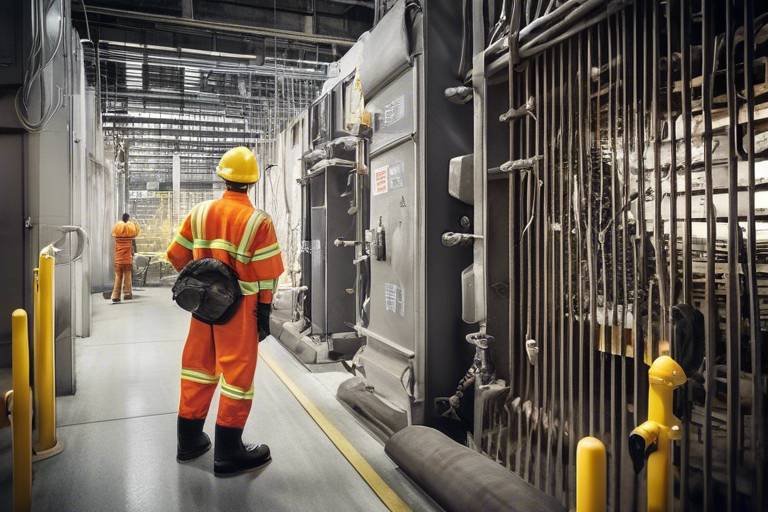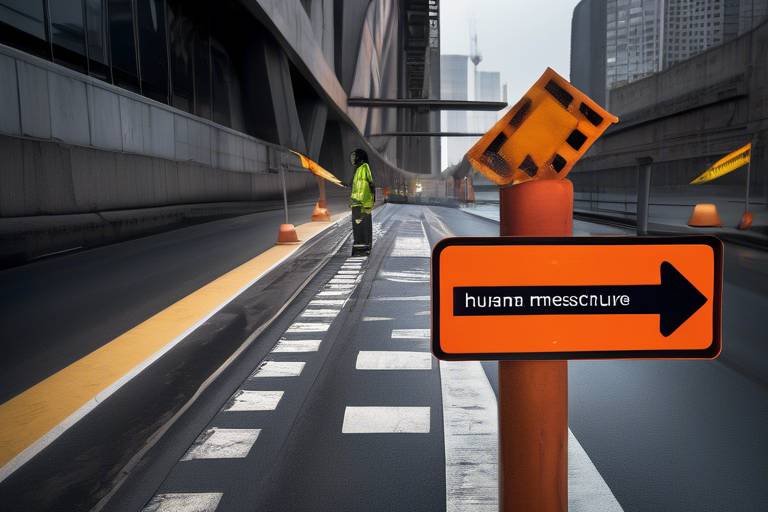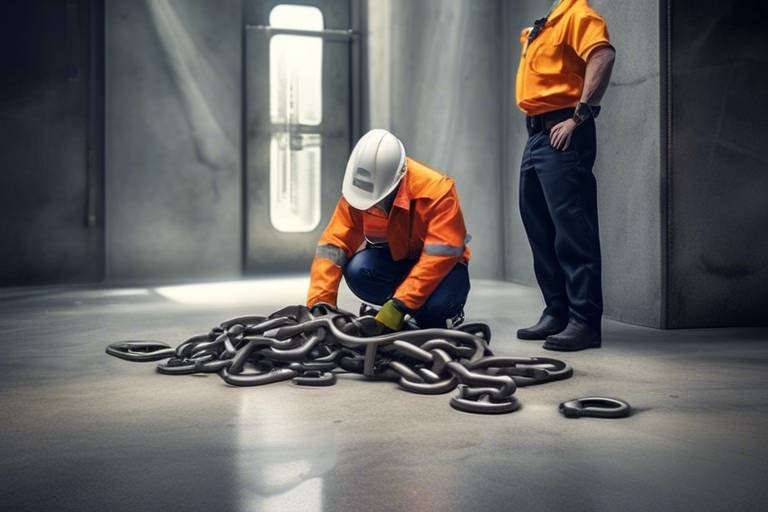Intertwining Safety Measurements and Human Behavior: A Study Guide
This guide explores the relationship between safety protocols and human behavior, examining how they influence one another and the implications for various fields, including psychology, engineering, and organizational management. Understanding this intricate connection is not just an academic exercise; it is essential for creating effective safety measures that resonate with the people they aim to protect. When we talk about safety, we often think about rules and regulations, but what about the people who are supposed to follow them? This guide aims to bridge that gap, shedding light on how human behavior can be both a risk factor and a solution in safety contexts.
Understanding safety measurements is crucial for minimizing risks and ensuring well-being in various environments. Safety measurements serve as the backbone of any safety system, providing a framework that helps organizations identify hazards and implement appropriate controls. Think of safety measurements as the guardrails on a winding road; they guide us and keep us from veering off course. In industries ranging from construction to healthcare, compliance with safety standards is not merely a legal requirement but a moral obligation. By adhering to these standards, organizations can significantly reduce the likelihood of accidents, injuries, and even fatalities.
Moreover, safety measurements are continually evolving. With advancements in technology and a deeper understanding of human behavior, safety protocols are becoming more sophisticated. This evolution necessitates that organizations remain vigilant and adaptable, ensuring that their safety measurements are not only compliant but also effective. The importance of compliance cannot be overstated; it is the first line of defense against potential hazards.
Human behavior significantly impacts safety outcomes. It's not just about having the right safety gear or protocols in place; it's about how individuals interact with these systems. Psychological factors play a pivotal role in influencing decision-making and risk assessment in safety-related situations. For example, consider a worker who is aware of the safety protocols but chooses to ignore them because they believe they can handle the situation without following the rules. This kind of behavior can have dire consequences, highlighting the need for organizations to incorporate behavioral insights into their safety protocols.
Cognitive biases can skew perceptions of risk and safety. These biases are mental shortcuts that can lead to irrational decision-making. For instance, a common bias is the overconfidence bias, where individuals overestimate their abilities and underestimate risks. This can be particularly dangerous in high-stakes environments like construction sites or factories, where a moment's lapse in judgment can lead to serious accidents.
Overconfidence can lead individuals to underestimate risks. This part explores how overconfidence affects safety behavior and decision-making, providing examples from various sectors where this bias has led to safety failures. Imagine a seasoned pilot who has flown for years and feels invincible. This overconfidence may lead them to skip important pre-flight checks, believing they know better. Such decisions can have catastrophic consequences, illustrating the need for ongoing training and awareness to combat this bias.
Normalization of deviance occurs when unsafe practices become accepted. This phenomenon develops gradually; what starts as a minor deviation from safety protocols can become the norm over time. For instance, if a construction crew routinely skips a safety check without incident, they may begin to see this as acceptable behavior. This mindset can erode an organization's safety culture and lead to disastrous outcomes. Vigilance is crucial in maintaining safety standards and ensuring that all team members are held accountable for their actions.
Effective training and education are vital for promoting safety awareness. Organizations must prioritize comprehensive training programs that not only cover safety protocols but also delve into the psychology of human behavior. Best practices in safety training programs should include interactive elements, such as role-playing scenarios and feedback sessions, to engage employees actively. These methods can significantly impact fostering a culture of safety within organizations.
Integrating safety measurements with behavioral insights can enhance safety protocols. By understanding the psychological factors that influence behavior, organizations can develop more effective safety measures. For example, incorporating nudge theory—which suggests that small changes in the environment can significantly impact behavior—can lead to improved compliance with safety protocols.
Behavioral safety programs focus on changing unsafe behaviors through positive reinforcement. These programs are designed to encourage safe practices by rewarding individuals for adhering to safety protocols. Successful case studies from various settings have shown that when employees feel recognized for their safe behaviors, they are more likely to continue those practices. It’s like planting a seed; with the right conditions and care, it can grow into something fruitful.
Feedback mechanisms are essential for refining safety practices. Gathering and analyzing feedback can lead to continuous improvements in safety measurements and human behavior alignment. Organizations should implement regular safety audits and encourage open communication among employees to identify areas for improvement. This collaborative approach not only enhances safety protocols but also fosters a sense of ownership and responsibility among team members.
- What are safety measurements?
Safety measurements are standards and protocols designed to minimize risks and ensure the well-being of individuals in various environments. - How does human behavior impact safety?
Human behavior significantly influences safety outcomes, as individual decisions and actions can either enhance or compromise safety measures. - What are cognitive biases?
Cognitive biases are mental shortcuts that can lead to irrational decision-making, often skewing perceptions of risk and safety. - What is normalization of deviance?
Normalization of deviance occurs when unsafe practices become accepted over time, leading to a decline in safety standards. - How can organizations improve safety awareness?
Organizations can improve safety awareness through effective training programs, behavioral safety initiatives, and open communication channels.

The Importance of Safety Measurements
Understanding safety measurements is crucial for minimizing risks and ensuring well-being in various environments. Safety measurements serve as the backbone of any effective safety strategy, providing a structured approach to identifying, assessing, and managing potential hazards. In a world where unforeseen events can lead to disastrous consequences, having robust safety protocols in place is not just advisable; it's essential. Think of safety measurements as the seatbelt in your car—something that may seem like a simple addition, but can save lives when it matters most.
Across various industries, from construction to healthcare, the role of safety measurements cannot be overstated. They enhance safety standards by:
- Identifying Risks: Safety measurements help organizations pinpoint potential hazards before they escalate into serious incidents.
- Establishing Standards: They provide a framework for compliance with legal and ethical safety standards, ensuring that organizations meet industry regulations.
- Promoting a Safety Culture: By prioritizing safety measurements, organizations foster a culture where safety is valued and prioritized by all employees.
Moreover, compliance with safety measurements not only protects employees but also enhances the organization's reputation. Companies that prioritize safety tend to attract more skilled workers and gain the trust of clients and stakeholders. It's a win-win situation—by investing in safety, you invest in the future of your organization.
In addition, consider the financial implications of neglecting safety measurements. The costs associated with workplace accidents—medical expenses, legal fees, and lost productivity—can be staggering. According to recent studies, organizations that implement effective safety protocols can reduce accidents by up to 50%. This not only saves lives but also significantly lowers operational costs.
In conclusion, the importance of safety measurements cannot be understated. They are not just a set of rules to follow; they are a fundamental aspect of organizational success. By integrating safety measurements into everyday practices, organizations can create a safer work environment that benefits everyone involved. So, the next time you think about safety, remember that it's not just about compliance—it's about creating a culture where everyone feels secure and valued.

Human Behavior in Safety Contexts
When we think about safety, it’s easy to focus solely on the protocols and measurements in place. However, the reality is that human behavior plays a critical role in determining the effectiveness of these safety measures. Our actions, decisions, and even our subconscious biases can significantly influence safety outcomes, often in unexpected ways. Understanding these behaviors is essential for developing effective safety protocols that not only comply with regulations but also resonate with the people who are meant to follow them.
At the core of safety contexts lies the intersection of psychology and practical application. The decisions individuals make in potentially hazardous situations are often influenced by a variety of factors, including their past experiences, emotional states, and even the environment around them. For instance, a worker in a high-risk environment may feel a sense of familiarity with their surroundings, leading to a false sense of security. This feeling can create a disconnect between the perceived and actual risks, ultimately affecting their safety behavior.
Moreover, it's important to recognize that safety is not just an individual responsibility; it is also a collective one. In organizational settings, the culture surrounding safety can either promote or hinder safe practices. When employees observe their peers engaging in unsafe behaviors without repercussions, they may feel justified in doing the same. This phenomenon often leads to a cycle where unsafe practices become normalized, creating a challenging environment for maintaining high safety standards.
To illustrate the complex relationship between human behavior and safety, consider the following psychological factors:
- Risk Perception: How individuals assess the likelihood and severity of potential hazards can vary widely, influenced by personal experiences and cognitive biases.
- Motivation: The drive to adhere to safety protocols can be affected by various incentives, whether they are intrinsic (personal values) or extrinsic (rewards or punishments).
- Social Influence: The behaviors and attitudes of peers can significantly impact an individual's approach to safety, making social dynamics a crucial aspect to consider.
Understanding these factors is vital for creating effective safety protocols. Organizations can benefit from incorporating behavioral insights into their safety training programs. By addressing the psychological aspects of decision-making, companies can foster a culture where safety is prioritized and ingrained in everyday practices. This not only enhances compliance with safety measures but also leads to a more engaged and safety-conscious workforce.
In conclusion, human behavior is a pivotal element in safety contexts that cannot be overlooked. By recognizing the psychological factors that influence decision-making and risk assessment, organizations can develop more effective safety protocols that resonate with their employees. This holistic approach not only minimizes risks but also cultivates a culture of safety that can lead to improved outcomes across various fields.
- Why is human behavior important in safety contexts? Human behavior affects how safety protocols are followed and can influence the overall safety culture within an organization.
- What are some common psychological factors that impact safety? Factors such as risk perception, motivation, and social influence play significant roles in how individuals approach safety.
- How can organizations improve safety through behavioral insights? By integrating psychological principles into safety training and protocols, organizations can foster a more effective safety culture.

Cognitive Biases Affecting Safety Decisions
When it comes to safety, our brains can sometimes play tricks on us. Cognitive biases are like those sneaky little gremlins that distort our perception of reality, leading us to make decisions that might not be in our best interest. Imagine you're driving a car, and you see a stop sign. But instead of stopping, you think, "Oh, I've done this a thousand times; I can just roll through." That’s overconfidence bias at work! This bias can lead to dangerous situations, as people often underestimate risks associated with their actions.
Another common bias is the normalization of deviance, where individuals or organizations start to accept unsafe practices because they seem to work without immediate consequences. For example, if a construction crew skips wearing hard hats and nothing seems to go wrong for a while, they might start to believe that the risk is negligible. This gradual acceptance of unsafe behavior can snowball, creating a culture where safety protocols are viewed as optional rather than essential.
To illustrate the impact of cognitive biases on safety decisions, consider the following table that summarizes a few key biases and their effects:
| Cognitive Bias | Description | Impact on Safety |
|---|---|---|
| Overconfidence Bias | Believing one’s skills or knowledge are greater than they actually are. | Underestimating risks, leading to unsafe practices. |
| Normalization of Deviance | Accepting unsafe behaviors because they seem to work without immediate consequences. | Creating a culture of complacency regarding safety. |
| Availability Heuristic | Relying on immediate examples that come to mind when evaluating risks. | Overestimating the likelihood of rare events due to recent exposure. |
These biases not only affect individual decisions but can also ripple through an organization, influencing group behavior and overall safety culture. The key takeaway here is that awareness is the first step toward mitigation. By understanding these biases, organizations can implement training and awareness programs that help employees recognize when their judgment might be clouded by these cognitive distortions.
Incorporating behavioral insights into safety protocols can lead to a more robust safety culture. For instance, regular workshops that challenge these biases and emphasize the importance of adhering to safety measures can be incredibly beneficial. So, the next time you think about cutting corners, remember that it’s not just about you; it’s about everyone around you.

Overconfidence Bias
Overconfidence bias is a fascinating psychological phenomenon where individuals tend to overestimate their knowledge, skills, and abilities. It’s like walking into a room full of mirrors, each reflecting a version of yourself that’s a little more exaggerated than the last. This bias can lead people to believe they are less susceptible to risks than they actually are, which can have dire consequences in safety-critical environments. For instance, consider a construction worker who feels confident in their ability to operate heavy machinery without proper training. This misplaced confidence can result in accidents that not only endanger the worker but also their colleagues.
In many industries, overconfidence can manifest in various ways. For example, in healthcare, a surgeon might underestimate the risks associated with a complex procedure, assuming their expertise will carry them through without complications. This kind of thinking can lead to serious mistakes. A study conducted by the National Institutes of Health found that healthcare professionals often rated their skills significantly higher than objective assessments indicated. Such discrepancies highlight the need for a more grounded approach to self-assessment and risk evaluation.
To understand the implications of overconfidence bias, let’s look at some key areas where it commonly occurs:
- Workplace Safety: Employees may believe they can bypass safety protocols because they feel “invincible.” This can lead to increased accidents and injuries.
- Driving: Many drivers think they are above average, leading to risky behaviors like speeding or texting while driving.
- Sports: Athletes may ignore their coach’s advice, believing their own instincts are superior, which can lead to injuries or poor performance.
Addressing overconfidence bias requires a multifaceted approach. Organizations should implement training programs that emphasize the importance of realistic self-assessment and risk awareness. By fostering an environment where employees are encouraged to recognize their limitations, companies can significantly enhance their overall safety culture. For instance, regular safety drills and reflective practices can help individuals understand the real risks they face, countering the overconfidence that might otherwise lead to dangerous situations.
Moreover, feedback is crucial in combating this bias. When individuals receive constructive criticism about their performance, it can help ground their self-perception. By regularly evaluating performance and discussing potential risks, organizations can create a culture of continuous improvement. This approach not only helps in mitigating overconfidence but also encourages a more collaborative and safety-oriented workplace.
In conclusion, while overconfidence bias can lead to serious safety risks, awareness and proactive measures can help mitigate its effects. By fostering an environment of humility and continuous learning, organizations can ensure that their employees remain vigilant and aware of the risks around them, ultimately leading to safer workplaces.

Normalization of Deviance
The concept of is a fascinating yet alarming phenomenon that occurs when individuals or organizations begin to accept unsafe practices as the norm. It’s like watching a slow-motion train wreck; you see it coming, but somehow, no one takes action until it’s too late. This acceptance often stems from repeated exposure to risky behaviors that don't immediately result in negative consequences. Over time, these behaviors become integrated into the routine, leading to a dangerous complacency regarding safety standards.
For instance, consider a workplace where employees routinely skip safety gear because they believe they can perform their tasks without it. Initially, they might get away with it, and as a result, the practice becomes normalized. This gradual shift can create a culture where safety protocols are viewed as optional rather than essential. The implications of such a mindset are profound, as it can lead to severe injuries or even fatalities.
To better understand this concept, let’s look at some key factors that contribute to the normalization of deviance:
- Desensitization: Repeated exposure to risky behavior can dull the senses, making individuals less aware of potential dangers.
- Peer Influence: When colleagues engage in unsafe practices, it creates a social norm that others may feel pressured to follow.
- Lack of Consequences: If unsafe behaviors do not lead to immediate negative outcomes, individuals may wrongly assume that these practices are safe.
Organizations must remain vigilant to combat the normalization of deviance. This vigilance involves establishing a robust safety culture that emphasizes adherence to safety protocols, regardless of past experiences. Regular training sessions, open communication about safety concerns, and encouraging employees to speak up can help mitigate the risks associated with this phenomenon. Furthermore, leaders should model safe behavior, reinforcing the idea that safety is a priority, not an afterthought.
In conclusion, the normalization of deviance serves as a stark reminder of the importance of maintaining high safety standards and the need for continuous vigilance in any environment. By recognizing and addressing this issue, organizations can foster a culture of safety that protects their employees and enhances overall productivity.
- What is normalization of deviance?
It refers to the process by which unsafe practices become accepted as normal within an organization, often leading to increased risks. - How can organizations combat normalization of deviance?
By promoting a strong safety culture, providing continuous training, and encouraging open communication about safety concerns. - What are some examples of normalization of deviance?
Examples include skipping safety gear, ignoring safety protocols, and accepting shortcuts that compromise safety.

Training and Education for Safety Awareness
When it comes to fostering a culture of safety, training and education are not just important—they're absolutely essential. Imagine walking into a workplace where every employee is not only aware of the safety protocols but also actively engaged in promoting them. This is the kind of environment that effective training can create. It’s about more than just compliance; it’s about cultivating a mindset where safety becomes second nature. But how do we get there?
First off, let's talk about the structure of training programs. A well-rounded safety training program should include both theoretical and practical components. Theoretical knowledge provides the 'why' behind safety protocols, while practical training equips employees with the skills to implement them effectively. For instance, a construction site might conduct classroom sessions on hazard recognition followed by hands-on drills where workers practice using safety equipment. This combination not only enhances understanding but also builds confidence in applying safety measures in real-world scenarios.
Moreover, the frequency of training sessions plays a critical role in maintaining safety awareness. Regular refresher courses can help keep safety at the forefront of employees’ minds. This is especially crucial in industries where the work environment or safety regulations may change frequently. By ensuring that training is an ongoing process rather than a one-time event, organizations can reinforce the importance of safety and adapt to new challenges as they arise.
Another key aspect is the use of interactive training methods. Traditional lectures can sometimes lead to disengagement, especially if the content is dry or overly technical. Incorporating interactive elements such as group discussions, role-playing, and simulations can make training more engaging. For example, using virtual reality (VR) technology to simulate hazardous situations allows employees to experience risks in a controlled environment, making the lessons more impactful.
Additionally, it’s vital to tailor training programs to the specific needs of different roles within the organization. A one-size-fits-all approach often falls short. Instead, consider developing specialized training modules for various departments. For instance, the safety training for a warehouse team might focus on material handling and equipment safety, while the office staff might require training on ergonomics and emergency evacuation procedures. This targeted approach ensures that all employees receive relevant information that they can apply directly to their work.
Lastly, let’s not forget about the importance of feedback in the training process. After each training session, gathering feedback from participants can provide valuable insights into what worked and what didn’t. This feedback loop allows organizations to continuously refine their training programs, making them more effective over time. For example, if employees indicate that they found a particular module confusing, this can be revised to enhance clarity and understanding.
In conclusion, investing in training and education for safety awareness is not just a regulatory obligation; it’s a strategic move that can lead to a safer, more productive workplace. By focusing on comprehensive, engaging, and tailored training programs, organizations can cultivate a culture where safety is prioritized, ultimately reducing risks and enhancing overall well-being.
- What is the primary goal of safety training? The main goal is to ensure that employees understand safety protocols and can apply them effectively to minimize risks.
- How often should safety training be conducted? Safety training should be ongoing, with regular refresher courses to keep information current and top-of-mind.
- What are some effective training methods? Interactive methods such as simulations, group discussions, and hands-on practice are effective in engaging participants.
- Why is feedback important in safety training? Feedback helps organizations identify areas for improvement and adapt training programs to meet employees' needs.

Integrating Safety and Behavioral Insights
Integrating safety measurements with behavioral insights is not just a trend; it's a necessity in today's complex environments. Imagine trying to navigate a maze blindfolded. That's how many organizations operate when they ignore the human element in safety protocols. By understanding how people think and behave, we can create a safer, more compliant workplace. This integration allows us to address the root causes of unsafe behaviors, rather than merely applying band-aid solutions that often fail to stick.
One of the most effective strategies for this integration is the use of psychological principles in safety practices. For instance, when we acknowledge that human behavior is often driven by emotions and biases, we can tailor our safety protocols to better resonate with employees. This might include incorporating elements of nudging—a concept from behavioral economics that subtly guides choices without restricting options. For example, placing safety reminders in visible locations can serve as constant prompts, reminding individuals of their responsibilities without feeling intrusive.
Moreover, organizations can benefit from behavioral safety programs. These programs focus on identifying and changing unsafe behaviors through positive reinforcement. Instead of merely punishing unsafe actions, these programs encourage employees to adopt safer practices by recognizing and rewarding their compliance. This shift in focus from punishment to encouragement can significantly improve workplace morale and foster a culture of safety. For example, a construction company might implement a program where workers receive points for adhering to safety protocols, which can later be redeemed for rewards. This not only enhances safety but also boosts employee engagement.
Another crucial aspect of integrating safety and behavioral insights is the establishment of feedback mechanisms. Continuous improvement is key in any safety program, and feedback serves as the backbone of this process. Organizations should create open channels for employees to share their experiences and suggestions regarding safety protocols. This could be through regular surveys, suggestion boxes, or even informal discussions during team meetings. Analyzing this feedback can reveal patterns and areas needing attention, allowing for adjustments that reflect the actual experiences of those on the front lines.
To illustrate the impact of this integration, consider the following table that summarizes the benefits of combining safety measurements with behavioral insights:
| Integration Strategy | Benefits |
|---|---|
| Psychological Principles | Enhanced compliance through relatable protocols |
| Behavioral Safety Programs | Improved morale and engagement, reduced unsafe behaviors |
| Feedback Mechanisms | Continuous improvement and adaptation to real-world challenges |
In conclusion, integrating safety measurements with behavioral insights is a powerful approach that can lead to significant improvements in workplace safety. By understanding the psychological factors that influence behavior, organizations can create more effective safety protocols that not only protect employees but also foster a culture of safety. As we move forward, it's essential to keep the conversation going about how we can better align our safety practices with human behavior, ensuring that safety is not just a checkbox but a core value ingrained in the organizational culture.
- What are behavioral safety programs? Behavioral safety programs focus on changing unsafe behaviors by using positive reinforcement methods, encouraging employees to adopt safer practices.
- How can feedback mechanisms improve safety? Feedback mechanisms allow organizations to gather insights from employees about safety practices, enabling continuous improvement and adaptation to real-world challenges.
- Why is it important to consider human behavior in safety protocols? Understanding human behavior helps organizations create safety protocols that resonate with employees, leading to better compliance and a culture of safety.

Behavioral Safety Programs
Behavioral safety programs are essential tools designed to enhance workplace safety by focusing on the behaviors that lead to accidents and injuries. Unlike traditional safety programs, which often emphasize compliance with rules and regulations, behavioral safety programs aim to change unsafe behaviors through positive reinforcement and proactive engagement. This approach recognizes that human behavior is a critical factor in safety outcomes, and by addressing the behaviors directly, organizations can foster a culture of safety that resonates with employees on a personal level.
One of the most significant advantages of implementing behavioral safety programs is their ability to create a shared responsibility for safety among all employees. When everyone is encouraged to participate actively in safety discussions and practices, it cultivates an environment where safety becomes a collective priority rather than a top-down mandate. For instance, when employees are empowered to identify hazards and suggest improvements, they are more likely to feel invested in the safety culture of their organization.
To illustrate the effectiveness of behavioral safety programs, consider the following key components:
- Observation and Feedback: Regular observations of employee behaviors related to safety can provide valuable insights. By giving constructive feedback, organizations can reinforce safe practices and address unsafe behaviors in real-time.
- Positive Reinforcement: Recognizing and rewarding safe behaviors can motivate employees to adhere to safety protocols. This could be through verbal praise, safety awards, or even small incentives.
- Training and Education: Continuous education on safety practices and the psychology behind safe behavior helps employees understand the importance of their actions and decisions.
Moreover, research has shown that organizations that implement behavioral safety programs often experience a noticeable decline in workplace incidents. For example, a case study conducted in a manufacturing plant revealed a staggering 40% reduction in accidents after the introduction of a behavioral safety program. This success was attributed to increased employee engagement and a deeper understanding of the risks associated with their tasks.
However, for these programs to be truly effective, they must be tailored to fit the unique culture and needs of the organization. A cookie-cutter approach will likely fall flat; instead, organizations should involve employees in the development of these programs, ensuring that they address specific behaviors and risks relevant to their work environment. This not only enhances the relevance of the program but also fosters a sense of ownership among employees.
In conclusion, behavioral safety programs are not just about compliance; they are about transforming the workplace culture into one where safety is prioritized and valued. By focusing on behaviors, reinforcing safe practices, and fostering open communication, organizations can create a safer work environment that benefits everyone. As we move forward, integrating these programs with traditional safety measures will be key to achieving comprehensive safety solutions.
- What are behavioral safety programs?
Behavioral safety programs are initiatives designed to improve workplace safety by focusing on changing unsafe behaviors through positive reinforcement and employee engagement. - How do behavioral safety programs differ from traditional safety programs?
While traditional safety programs often focus on compliance with rules, behavioral safety programs emphasize changing behaviors and fostering a culture of safety among all employees. - What are the benefits of implementing a behavioral safety program?
Benefits include increased employee engagement, a decline in workplace incidents, and a shared responsibility for safety among employees. - Can behavioral safety programs be customized?
Yes, effective behavioral safety programs should be tailored to fit the unique culture and needs of the organization to ensure relevance and effectiveness.

Feedback Mechanisms for Continuous Improvement
In the realm of safety protocols, feedback mechanisms play a pivotal role in fostering continuous improvement. Imagine a well-oiled machine; each part needs to work harmoniously for the entire system to function effectively. Similarly, feedback serves as the lubricant that keeps safety systems running smoothly. By actively gathering and analyzing feedback, organizations can identify potential weaknesses in their safety measures and make necessary adjustments. This proactive approach not only enhances safety but also builds a culture of accountability and transparency.
Feedback can come from various sources within an organization, including employees, management, and even external stakeholders. For instance, frontline workers often have firsthand experience with safety protocols and can provide valuable insights into what works and what doesn’t. By creating channels for open communication, organizations can encourage team members to share their thoughts without fear of repercussions. This not only improves morale but also ensures that safety practices are grounded in real-world experiences.
To implement effective feedback mechanisms, organizations can utilize a variety of tools and strategies. Here are some common methods:
- Surveys and Questionnaires: Regularly distribute surveys to gather employee opinions on safety measures. This can help pinpoint areas needing improvement.
- Incident Reporting Systems: Encourage employees to report near misses or unsafe conditions. Analyzing these reports can reveal patterns that need addressing.
- Safety Meetings: Hold regular safety meetings where employees can discuss their concerns and suggestions. This fosters a collaborative environment.
Moreover, it’s crucial to analyze the feedback systematically. Organizations can employ data analysis techniques to identify trends and recurring issues. For instance, if multiple employees report feeling unsafe due to inadequate lighting in a particular area, this signals an urgent need for intervention. By prioritizing these concerns, organizations can make informed decisions that enhance overall safety.
Additionally, feedback should not only be collected but also acted upon. Organizations must communicate the changes made as a result of employee feedback. This creates a sense of ownership among team members and reinforces the idea that their voices matter. For example, if a suggestion leads to improved safety equipment, sharing this success story can motivate others to contribute their ideas.
To illustrate the impact of feedback mechanisms, consider a case study of a manufacturing plant that implemented a robust incident reporting system. Initially, employees were hesitant to report near misses due to fear of blame. However, after establishing a non-punitive reporting culture and regularly discussing the insights gained from reports, the plant saw a significant reduction in accidents. This transformation not only saved lives but also boosted employee morale and productivity.
In conclusion, feedback mechanisms are indispensable for continuous improvement in safety protocols. By actively seeking input from all levels of an organization and making data-driven decisions, companies can create a safer work environment. Remember, safety is not a destination but a journey, and feedback is the compass that guides us along the way.
Q1: What are feedback mechanisms?
A feedback mechanism is a system that allows organizations to gather, analyze, and act upon input from employees and stakeholders regarding safety protocols and practices.
Q2: Why is feedback important for safety?
Feedback is crucial as it helps identify weaknesses in safety measures, promotes a culture of transparency, and encourages employee engagement in safety practices.
Q3: How can organizations encourage feedback?
Organizations can encourage feedback by creating open communication channels, ensuring anonymity in reporting, and fostering a non-punitive environment for sharing concerns.
Q4: What are some effective feedback tools?
Effective tools include surveys, incident reporting systems, and regular safety meetings that allow for discussion and collaboration on safety issues.
Frequently Asked Questions
- What are safety measurements and why are they important?
Safety measurements are systematic approaches used to assess and manage risks in various environments. They are crucial because they help minimize hazards, protect individuals, and ensure compliance with safety standards across different industries. By implementing effective safety measurements, organizations can create safer workplaces and reduce the likelihood of accidents.
- How does human behavior influence safety outcomes?
Human behavior plays a significant role in safety outcomes because it affects decision-making and risk assessment. People often make choices based on cognitive biases and emotional responses, which can lead to unsafe practices. Understanding these behaviors allows organizations to develop better safety protocols that account for the psychological factors influencing their employees' actions.
- What are some common cognitive biases that affect safety decisions?
Common cognitive biases include overconfidence bias, where individuals underestimate risks, and normalization of deviance, where unsafe practices become accepted. These biases can skew perceptions of safety and lead to poor decision-making. Awareness and training about these biases are essential in mitigating their effects on safety outcomes.
- How can organizations promote safety awareness through training?
Organizations can promote safety awareness by implementing effective training programs that focus on real-life scenarios and behavioral insights. Best practices include interactive workshops, regular safety drills, and ongoing education. By fostering a culture of safety through comprehensive training, organizations can empower employees to prioritize safety in their daily activities.
- What are behavioral safety programs and how do they work?
Behavioral safety programs aim to change unsafe behaviors by using positive reinforcement techniques. These programs encourage safe practices through rewards and recognition, creating a supportive environment for safety. Successful case studies show that when employees feel valued for their safe behaviors, they are more likely to maintain those practices consistently.
- Why are feedback mechanisms essential for safety improvement?
Feedback mechanisms are crucial because they provide insights into the effectiveness of safety protocols and highlight areas for improvement. By gathering and analyzing feedback from employees, organizations can continuously refine their safety measurements and align them better with human behavior, leading to enhanced overall safety performance.



















